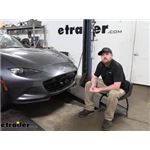Roadmaster Direct-Connect Base Plate Kit - Removable Arms

Will this fit?
To see if this custom-fit item will work for you please tell us what vehicle you'll use it with.
Thank you! Your comment has been submitted successfully. You should be able to view your question/comment here within a few days.
Error submitting comment. Please try again momentarily.
- All Info
- Reviews (2083)
- Q & A (0)
- Videos (1)
- Photos
Roadmaster Tow Bar Base Plate - RM-524450-5
- Roadmaster
- Removable Draw Bars
- Twist Lock Attachment
Designed for use with motor-home-mounted tow bars, the direct-connect brackets are virtually invisible, easy to mount and remove, and they eliminate the need for a quick-disconnect crossbar on your tow bar. Installs on your vehicle's frame.
Features:
- Direct-connect brackets provide attachment points for your motor-home-mounted tow bar
- Streamlined design creates supremely clean look
- No obtrusive quick-disconnect crossbar
- Hidden brackets sit even farther back than standard brackets
- Drawbars attach and remove quickly and easily
- Arms click to lock in place in brackets
- Built-in pull rings let you unlock arms so you can twist and remove them
- Computer-cut, all-steel construction provides exceptional strength
- Black powder coat finish is durable and corrosion resistant
- Simple installation - no welding required
- Custom base plates ensure a perfect fit for your vehicle
- Compatible with Roadmaster motor-home-mounted tow bars only
- Instructions and mounting hardware included
- Made in the USA
- Limited Lifetime Warranty
Note: Roadmaster direct-connect base plates will only work with Roadmaster tow bars that slide into a trailer hitch, such as the Nighthawk, Sterling, Blackhawk, Blackhawk 2, Falcon, or Falcon 2. These base plates will not work with tow bars that require a hitch ball.
The drawbars, or front arms, on this base plate kit are supremely easy to mount and remove. Just insert them into the brackets and twist to lock them in place. To remove each arm, simply tug the built-in pull pin to disengage the lock, twist the arm back and pull it out of the bracket. Once the drawbars have been removed, the remaining brackets are virtually invisible. On most automobiles, the brackets are mounted within the grille, where they remain not only unseen, but protected from scrapes and scuffs as well.
524450-5 Road Master EZ-5 Base Plate Kit
Installation DetailsThis Product Fits The Following Vehicles
- 2016 - 2023 Mazda MX-5 Miata Manual transmission


Videos are provided as a guide only. Refer to manufacturer installation instructions and specs for complete information.
Video Transcript for Roadmaster Direct-Connect Base Plate Kit Installation - 2016 Mazda MX-5 Miata
Hey, everybody. Ryan here at etrailer. Today, on our 2016 Mazda MX-5 Miata, we're gonna be showing you how to install the Roadmaster base plate kit with removable arms. But before we do that, why don't we check it out and make sure that it's gonna work for you So before we get too carried away, I figured it'd be useful just to kinda touch base and refresh ourselves on the main parts that we're gonna need to flat tow our Mazda down the road in the first place. Now, usually, what we do is actually be hooked up to the motor home and paint a real good picture. But today, we have some really bad weather, and so we're just kinda trying to make do, so bear with us here.
With that said, there's gonna be a total of five main parts. First one is gonna be your base plate. And the purpose of this is to provide us with a solid and reliable connection point. That way, we can hook our tow bar up to it. Tow bar is gonna be the second component.
And what this is gonna do is be the physical link that actually connects the front of our Mazda to the back of the motor home. Third main component will be safety cables. And these are just there in the event of an unlikely disconnect. They're gonna keep everything paired together. Fourth main component will be the tow bar wiring.
And what that's gonna do is transfer the lighting functions from the back of our RV to the back of our Mazda, keeping us safe and legal. And last but not least, the fifth main component is going to be the supplemental braking system. And what this is gonna do is apply the brakes in your Miata whenever you hit the brakes in your motor home, helping to bring you to a more complete and predictable stop. But with that out of the way, let's check out the base plate. So if it we're me and I was wanting to flat tow my Miata, probably the first thing I would think of is how's it gonna look.
You know, sporty cars have an aggressive-type front end, and I think that would be one of my concerns. And honestly, with this setup here, I think it's about as good as it can possibly get because at the end of the day, you're still gonna have a lot of components up front here. So it's gonna be nearly impossible to have everything completely hidden and so on. But I feel like they did a pretty good job of, you know, keeping it as sleek as possible and still being easy to use, which kinda brings me to my next point. Since this does use removable arms, whenever you are ready to use it and hook up to your tow bar, it's gonna be really straightforward. All you're going to have to do is take the arms and place them into the base plate, rotate it about a quarter turn, and that's going to lock it in. And so once these are in there, that's gonna give you the mounting point to be able to hook that tow bar up to. So due to the bad weather, we put together kind of a little motor home simulator deal here, just so we could have our tow bar and stuff and try to paint a better picture of what's going on. So whenever you have your arms in and you're ready to hook up, you take your tow bar arms, line 'em right up. Take the pin, run it through, lock this pin in. And your safety cables will clip right through here. And obviously, you'd wanna hook up your other components and get them plugged in as well. So the base plate is gonna work with the Roadmaster Direct-Connect tow bars, you know, with the ends like this, so it'll plug right in. It'll also work with a lot of different other tow bars as well with the use of an adapter. So perfect scenario today, we actually have the etrailer.com SD tow bar, and we put the adapters on the ends, and that allows the two to pair together. So a lot of the different brands will have an option like this so you can do that. I will say with the etrailer tow bars as well as the Demco ones, the adapters aren't gonna come with the pins that actually lock them into the removable arm there. So you can always grab them separately. I can't speak for all the other manufacturers and their adapters, but definitely something to kinda think about and check into. You don't wanna get all your stuff and then come to realize that you can't even hook it up 'cause you're missing a pin. So I just wanted to point that out. This is what the front of your Mazda will look like whenever you're all hooked up to your motor home, for the most part, you know, as far as all this is concerned. And I think it looks good. You know, everything's organized, easy to see, easy to get to and everything else. So, you know, at the end of the day, a base plate's a really important piece to your flat tow puzzle, if you will. You want it to be reliable and everything else 'cause it's gonna be responsible for, you know, providing us with that good attachment point. And with this one, there's definitely an abundance of attachment points holding the base plate onto the vehicle, which kind of brings me to the installation side of it. As far as getting it on, it's probably one of the more difficult ones, I'd say. And it's not even really that it's, you know, over-the-top, confusing, or anything like that. There's just a lot of hardware, bolting everything together. So stay patient. As long as you take your time, really shouldn't run into too many issues. But speaking of install, why don't we go ahead and get it done together now To begin our installation, we're gonna be here at the front of our Mazda, and we already need to take off the front fascia. That way, we have the space we need to get our base plate on. And so what you're gonna do, pop the hood. Then, if you look along this edge here, we're gonna have three fasteners. So we'll have a Phillips head screw. Pull that out. We're gonna have two pushpins. And the way to get these out, you can take a flathead screwdriver, kinda just pry underneath the head and work it up till it comes out. Same thing for this one here. And I wanna mention from this point on, anything we do to one side of our vehicle, we're also gonna do to the other side 'cause it'll be set up the same way. Now, if we move to our front wheel well liner, we're gonna have four pushpin fasteners we need to pull out as well. It does help if you turn your wheels in one way or the other. You know, it gives you more space. But just like the other ones, we're going to pry underneath the head of 'em. These ones you might have to kinda finesse a little bit more. Being the wheel well, you know, they get dirt and stuff in there and you might have to kinda work 'em out a little bit better. So go ahead and do the same thing here to get all these out. So with the fasteners undone here, you can grab your liner and kinda peel that back. And there's just gonna be a light, and I'm just gonna quarter turn it. So just turn it quarter of the way, and that'll pop it out. And then, if we continue to work up where our front fascia actually meets the quarter panel, there's gonna be a screw going up, holding the two together. And so we're gonna pull that out using an eight-millimeter socket. Underneath the car, along this front edge, we're gonna have some more fasteners. This one here in the corner, with these, you can use a Phillips head bit or it looks like, I think an eight-millimeter thick bit as well. We'll work our way around. And then, there's gonna be a pushpin right here that we'll pull out too. And in the middle of our vehicle, we'll have two more fasteners holding this plastic cardboard shield on with a Phillips or an eighth. And then, you should be able to kinda lift that up and pop it down a little bit. Now, with and extra set of hands, we can get our fascia off. I do wanna note I put some painter's tape along the seams and everything. That way, we don't have to worry about scratching it. But what you're gonna do is just work from the corner, and actually, it's coming right off. So continue to work it out. Looks like we might have some electrical connectors here. That's just securing the wiring to our fog light assembly. But these aren't popping out. Sometimes, what we'll need to do is grab a trim panel tool or a flathead screwdriver to help kinda pry up on that. Since that piece is pried off, that should disconnect this here. So you push down on that tab, pull it off, and that should be it. Obviously, it'll be set up the same way on the other side. So once that's disconnected, we can get this removed. And with all that out of the way, we can set our fascia off to the side. So if you look underneath your bumper beam, there's gonna be this plastic air dam deal right here on the side. And we just need to trim off a small portion of it. So to make it easier, I'm gonna take out this pushpin fastener. That should allow us to kinda pull it down some. And essentially, I'm just gonna cut it flush with this piece that comes out there. So just use a pair of tin snips. Probably use a regular pair of snips or something along those lines as well. Regardless, this material does need to get removed. And once I have it trimmed off, go ahead and just pop this right back into place. So we're gonna pop this back in. If yours gets hung up, just look up top. 'Cause kinda prying it down, it might get hung up on other piece of plastic up there. So if that's the case, just check up there, but pop that back in. And now, we can remove these pieces here. So you're gonna have three 10-millimeter bolts. One there and two there. So I'll grab our socket, and pull these all out. And get this removed. If you look right here and we go up, we're gonna have some wiring attached to this plastic piece. So a trim tool will pop that off. And looks like that's all we'll have to pull off. And once that is off of here, we can remove these two 10-millimeter bolts. And get this piece out of the way. We can work more over to the side. We see here, we're gonna have a 10-millimeter, as well as that one. We'll get both of those out as well. Now, if you look kinda way up, honestly, you'll see this plastic splash shield. There's gonna be two bolts holding it in. There'll be a 10-millimeter, so there's one here. And then, we'll go underneath the car to see the other one, much easier to access. So we'll go ahead and get this one removed first. So if you look, here's the other bolt there, and it's kinda buried, but you can definitely get to it. More or less, just locate your front sway bar bushing, which is this piece here, and that bolt's right above it. Not a lot of room to work, so with this one, I'm just going to use a regular wrench and work this out by hand. So with that other bolt loose, you can grab the splash shield, get that out of the way. And what I'm gonna do is put these two bolts back in here. I thought by removing 'em, it'll make it a little bit easier to get those ones we just took out removed. Really didn't do much. So honestly, you know, if you want to, you could probably skip this step. If you already took 'em out, I mean, not really a huge deal. They're pretty easy to get to. We'll just run 'em back in. So what you can do now, this bolt right here, kinda behind this metal flange, we're gonna pull that out. So that's a 12-millimeter. And what we're gonna do is take some red Loctite. You can grab this here at etrailer. And all of the hardware that we're gonna use to secure the base plate is gonna receive some of this red Loctite. We're gonna take the support brace, and these are side-specific so make sure you have the right one, but this is gonna kinda sit up in there. This front part should line up pretty close with this hole right there. And this hole, you're gonna take that bolt we just pulled out, put it through, and then simply just resecure it up into place. Work that in there. I can manage to get this in here. Probably one of them deals where you just kinda have to spin it in just right. Once that's up into place where it needs to be, we can take that bolt and we'll get that started. I'm just gonna try to hold this in position here. And while I'm doing that, we can tighten the bolt down. So this is the other side of our vehicle, and it's set up the same way. Just wanted to give a different view of what was just put in. Now, we can take our main receiver brace and line this up here. And what we're gonna do is you can take three of these bolts. We're gonna put on a split lock washer, flat washer, and we'll just get these started on each side, hand-tight. That way, the base plate will support itself. Once you have those three bolts started and hand-tight, we'll come back and snug 'em down. Now, if you look at her base plate and kinda buried up here, there's gonna be a hole in the base plate. And that'll go through that support bracket that we put on earlier. And you're gonna take one of these bolts, put on your Loctite, push that through. It's gonna be tricky to see, but on the other side where that bolt comes out, you're gonna put on a split lock washer and a hex nut. So once that bolt is in there, you can come back with a 19-millimeter or a 3/4-inch socket and wrench and snug this down. If you look now on that back brace, the hole closest to the back of the vehicle is gonna line up with the weld nut inside of the frame rail. And what you can do is take one of the smaller bolts, split lock washer, and flat washer, and thread this up into place. You can see how I have it started by hand. I'll come back with a 10-millimeter and snug it down. What we can do now over here is take off our headlight, some of this stuff, to give us access to that part of our frame. We're gonna have a wire connected to our induction system here, so we'll just pry that off, and we're gonna have a 10-millimeter head bolt there and pull that off. This might be connected more in the engine bay, kinda loosen it up, come back to it. I feel like if we take our headlight out first, it'll probably be easier to wiggle this piece out. But it looks like we're gonna have two more 10s. And a small plastic fastener. So this is a Phillips head. With these, you just lightly turn left. You don't wanna apply really any downward pressure. Almost just the weight of the screwdriver is enough. And we can work that out. What we can do now, this sensor here, we can remove that. So actually, there'll be this 10-millimeter bolt. We can pull that off. And then, we can disconnect our sensors around, sorry, our connectors in the bottom of the headlight. So you can push down on the tabs, and they're all gonna be pretty similar. And while you're pushing down on 'em, you can work 'em apart. This is probably gonna have to come free here. So I'm just thinking while the headlight is still somewhat attached, it'll probably be easier to do this stuff now as opposed to when it's disconnected and wants to fall down and everything. I have to work this out as well. And that looks like it's about it as far as that's concerned. There is gonna be another bolt right here. That will be a 10-millimeter. Go ahead and get that one removed as well. The headlight's still attached. Looks like maybe this bolt up here is still holding it in, so we'll pull that out. Hopefully, we can start to try to maneuver this out. Looks like it still wanna hit something, I might come back and actually pull that one out as well. It might just make it easier. Let's see if this piece actually needs to come off or get it loose enough to allow us to try to work our headlight out here. So that was holding that on, so put that out of the way. What we can do now is sneak out the headlight. Now, back in the engine compartment, if you look where that air intake tube starts to run, almost as soon as it enters the engine compartment down here, there's gonna be another bolt holding it in. So we'll pull that out with our 10, and it looks like after that, we should be good to go and be able to remove this. Get that outta the way and hopefully try to work this tube out of position. With all that stuff out of the way, we can now cut off this piece of metal. So there's a diagram in the instructions. It kinda tells you where to go. I marked that out. I'm gonna use an air saw like this, maybe a Dremel tool, combination of the both, kinda whatever you got to cut this out you can go with. So with that said, I'll go ahead and get this material removed. So with this cut out, I did shoot some spray paint on there just, you know, so we don't have bare metal exposed. Let it dry. And now, we can take these straps and put these on. These are side-specific, so pay attention to the instructions. Make sure you have the right one. But this is gonna lay on there like that. And you can see, that hole's gonna line up with the existing hole in our frame, which will go straight through. And on that support bracket that we bolted on to the bottom side, it's gonna line up with the hole in that as well. And so we're gonna set this on, and then we're gonna take the six-inch bolt and one of these small half-inch flat washers. And from the bottom up, run this all the way through until it comes out up here where we can get the rest of our hardware on it. So on the bottom side, we're gonna see that other hole in our back support brace lining up with the hole in the frame. We'll take our bolt we showed all the way up, like we talked about. Here up top, you see where our bolt's going through. With our bracket on it, take a split lock washer, don't forget your Loctite on the threads as well. Finish it off with a hex nut there. Let me just get this hand-tight right now. So now, back underneath. So if you remember the strap that we just put on, there's two holes in it. The other hole, we need to get attached. So that's gonna line up with this hole down here in our base plate. Problem is though, we have to create that hole. So I'm gonna take a my drill bit and drill straight as I can up through the frame. And that way, we can get some hardware in there. So with everything lined up, back up top, we can take the seven-inch bolt and drop that through. So when you're going to drop your bolt through, you can see that there's a space or gap in between the bottom of the frame and our base plate. And so you're gonna take the spacer block and line that on up, and then drop your bolt through it, and that spacer block will fill that gap there. Once totally dropped through, you can take a big, flat washer, a split lock washer, and a nut. So once that strap is in place and our two bolts, if you recall, we left both these hand-tight, we'll just come back and snug 'em down using a socket and wrench. On the side of our base plate here now, right above it, we're gonna have a wire that's connected to the frame, and we're just gonna pry that off, kinda move it out of the way and hopefully won't be in our way. 'Cause we're gonna take these side brackets. Again, these are side-specific so, you know, make sure you got the right one. And these are going to just sit here like that. It looks like the wire will clear. And you wanna make sure that this is pushed as far forward as possible. 'Cause if it's, you know, if it's a little crooked like that, where we put that other bolt down through the frame, if it's crooked, then chances are pretty good when you go to drill the hole, you know, that bolt's gonna be in the way. So make sure it's sitting up like that. And what we'll do first, these two holes, you're just gonna take these bolts, push those through. And then, on the backside of those bolts, we can get a split lock washer and a nut started. So here's our bolts. I put on our split lock washers. Get the nut started, and you're gonna hold that bracket how you want it, like we talked about, as far forward as you can. And while you're holding it, we'll come back and snug these down, so it stays in place. So with that tight, now, we can use this as a guide, the hole up here for our drill bit, and we're gonna drill straight through the whole frame. With the hole drilled, take your five-inch bolt and your Loctite, run that through to the other side. Then, on the other side, we can get on our flat washer, split lock washer, and nut. And once we have that hand-tight, we can come back and snug it down. Now, at this point, once all the bolts are in and snugged down, we can come back with a torque wrench and tighten down all of the hardware to the amount specified in the instructions. If you don't have a torque wrench, you can always grab one here at etrailer. Or a lot of times, you can go to your local auto parts store and they'll have one there available you can rent. So once everything is torqued, you can put your headlight and your air tube back in the opposite way that you removed it. And from here, it would be a great time to install any of your other flat towing components like wiring and your braking system. And I say that because with the front fascia off, you just have a lot more room to work. So that's exactly what I'm gonna do. And then, once we're done, we can trim the fascia out and put it back on. If you're not installing those components or you already have 'em in place, you would simply just reference your instructions. They'll tell you where you need to trim to allow access to the base plate. And then, you put the fascia back together. So now, with all of our flat towing components on and installed, we can come back to our fascia and we are gonna have to trim it out some like we talked about. So I referenced the diagram in the instructions and just kinda drew out where we're gonna cut. This is kind of an odd shape. I'm gonna use a small, little saw like this. You could probably use a Dremel tool or, you know, maybe some type of routing-type drill bit or a hole saw or something. You can come up with something, I'm sure. So what I'm gonna do is just very carefully cut the shape out here. So once that's cut out, you can do the same thing on the other side. And then, if you want, you can always come back with a file or razor edge or sandpaper, something like that, and kinda clean these edges up. So now with our fascia trimmed, we can reinstall it the opposite way that we removed it. And that'll finish up our look at and our installation of the Roadmaster base plate kit with removable arms on our 2016 Mazda MX-5 Miata..
Customer Reviews
Roadmaster Direct-Connect Base Plate Kit - Removable Arms - RM-524450-5
Average Customer Rating: 4.8 out of 5 stars (2080 Customer Reviews)
Designed for use with motor-home-mounted tow bars, the direct-connect brackets are virtually invisible, easy to mount and remove, and they eliminate the need for a quick-disconnect crossbar on your tow bar. Installs on your vehicle's frame.
Easy to use. Working with etrailer was great. If we need anything else on our motorhome we will be traveling out to etrailer.
Placed order on Monday, delivered on Thursday. Another company told me it would probably be 5 business before shipping since they ordered from a distributor. It will be a few days before I can tear into tearing the Miata apart to install the base plate.

Installation directions were well clear and easy to follow. All parts fit as shown in the installation directions. I have had no issues with the direct connect base plate.

Thorough installation instructions.

The faceplate works great I would recommend anyone that has a Miata by one if they are Towing behind an RV or any vehicle

I bought and self installed this on my 2021 GMC Sierra Duramax 1 year ago. Install took about 5 hours and wasn't difficult...I could problty install it in 2-3 hours after leaening the tricks. Weve towed the truck all over the USA since then (over 10,0000 miles) and it works great! I've used other brands and highly recommend Roadmaster tow systems over the competition.
I reported that one of the removable tow arms was missing to etrailer within hours of receiving the baseplate. This was due to the shipping box being damaged during transit and likely just fell out. After four business days with no communication from etrailer I contacted Roadmaster. A couple of emails and they shipped the part. Very disappointed having to do etrailer's legwork. For this I will give etrailer one star.
The baseplate RM 524473-5 for a 2023 Ford Escape fit as expected sorta. Had to apply a 3 pound hammer as the mounting brackets were tweaked a little likely from welding and pulling a little out of square. I felt the instructions had a lot of reading between the lines, a couple of times I just about picked up the phone and called them to see if my interpretation was correct. But I just consulted with my analytical 15 year old grandson and we figured it out. (His 18 year old brother served to knock me to the floor and pull me back up again, faster than calling a crane service.)
My big complaint was that they could have provided actual measurements where to drill the Tupperware where the arms go through, there is a couple of reverence points that could be used. There was a few minor things that didn't/did need to be done but likely could easily be because of running production changes. (And better packing of 45 pounds of steel by RM)
The tow bars hook up easily to my dinghy car, a 2020 Ford Escape Hybrid. I like that the arms dis-attach easily and can be stored elsewhere. The tow arms attach quickly and easily to the baseplate arms. I do like this system. The installers put it in, so I cannot comment on how easy that was. I know the installers contacted etrailer for their questions, so I was glad to hear that.
Everything went pretty good except for the reinstall of the PAD. Had to mount it on an angle because wire to short. Love it versus the crossbar I had on Santa Fe 5 speed. Also had to wire 12v outlet and emergency brake switch wiring into drivers side which was fairly easy. And 12v charging circuit for battery. My grandson Seth made it look easy.

Good product. If you are reasonably handy and have some tools, you can install this yourself in a few hours. I'm a mechanic, it took me a little over 2 hours to install on my own toad. The fit is good, there are 4 holes you have to drill, otherwise it is plug and play. When you insert and twist lock the tow bar mounts into their sockets they feel a little sloppy but they are secure, and i never noticed any rattle when towing. Overall i give it a 4 out of 5 for easy install and clean look after install. Pic included of installed base plate.

The Roadmaster direct connect base was a perfect fit for my 2013 focus S to flat tow. We had it installed in about 3 hrs following the complete direction and pictures. I highly recommend using etrailer.
The brackets are heavy and feel solid. The mounting is straightforward on my 2024 GMC Sierra Denali 1500. You will lose the front tow hooks but I feel the tow bracket inserts will be safe to use if needed for a rescue. They are barely noticeable to the casual person when the inserts are removed for daily driving.

Installed on my 2020 Jeep Cherokee for flat towing behind our motorhome . I wanted a tow bar connection that integrated with the front end of the Jeep and the removable arms did the trick . I had one issue with the driver side receiver bracket not lining up with the upper mount bolt hole on the Jeep, image 0547. Had to make a slight adjustment to the receiver bracket so the holes would line up, image 0551 and image 0559. The rest of the install went smoothly
I also installed the Demco braking Stay n Play Duo system , image 0565 which went in without any issues, image 6028. 7 thousand miles of towing later, couldn't be happier with the products
This is a rock solid baseplate. Installed on a 2023 Equinox LT (AWD). I followed etrailer's videos for installation and they are spot on. We connect with a Roadmaster Nighthawk tow bar, charge line kit, smart diode lighting kit, and a Demco Stay-in-Play supplimental braking system. It is fairly well hidden when not in-use. This setup is great!

It was a fantastic base plate. The Blue Ox base plates required the entire bumper, grill, etc be removed. These Roadmaster base plates were installed from underneath and only required the tow hooks be removed. My wife and I completed the installation in a couple hours. The stiff wires attached to the nuts that required installing inside the frame was genius. We bought Roadmaster to Blue Ox adapters and continue to use our Blue Ox towing equipment. The Roadmaster Nighthawk is just too heavy for me (I'm 78). Anyway, I love the Roadaster base plates. And, I'm thankful for the clear installation instructions provided etrailer.

Sturdy, simple to use design. The second set if Roadmaster base plate lits I have installed. (2015 Silverado and 2022 Colorado). Both work well. And oh yeah, do yourself a favor and buy from etrailer. If you have any hitches in the get along, those good folks will always help straighten things out.

I installed them on my new RAM 1500. Works great, very heavy duty. I also modified and attached a push bumper and used the Roadmaster base plates.
Exactly what I needed. Written jbstructuons were spot on and video was very helpful.
Installed on my 2020 jeep jl sport s with factory plastic bumper and plastic rock guard. Shane’s video was very helpful but I did not like how the metal plate behind the rock guard was cut away and how the rock guard had two big cut outs so I did some modifications. I cut two slots in the metal bracket and added angle brackets for extra support. As a result i did not use the supplied brackets for the rock guard. I created a template for the rock guard which resulted in two small cut outs. A lot of extra time but i am retired so time is relative. I think it looks great.
Installing on 2020 Jeep Trailhawk :
Pic #0557 : Roadmaster Base Plate Kit , Demco Supplemental Braking System , Diode Wiring Kit , Demco Battery Charge Wire Kit
Pic # 0548 ,0551 , 0559 Had to adjust the bracket plate to line up with the upper bolt holes
Pic #6028 finished install , mounted the operating unit to the top fuse box cover using automotive Velcro . Air cylinder , controller and LED light installed . Aside from the base plate bracket not lining up with the upper bolt holes I would give it 4 stars . My son in law is a master at solving mechanical issues .
Easy install. Looks great. Apparently they have made some changes so that the video is not accurate. Install instructions though were spot on. A template for cutting the grill would be an added plus.

The removable arms were an absolute pain to install. That might have been different if I had a better drill, but I had to drill holes in extremely thick metal to attach these arms and it took me awhile just to get the holes drilled. I went through bits and oil for hours to get the holes drilled, but I also didn't have the money to spend on buying specific additional tools for the project. The arms work great. Very nice to be able to remove the arms when you're not using them and then you can add them in about 5 seconds each if you need to use them. I installed them on a 2018 F-150 Roush.

I bought this base plate kit for my 2022 Jeep Rubicon Gladiator so I could flat tow behind my class a motor home with a Roadmaster Falcon all terrain non binding tow bar. The instructions were easy to follow and went smoothly except drilling the holes. That was my fault because I was using a dull drill bit. See attached photo
I was very pleased with the way you handled my order. I called and was greeted pleasantly and knowledgeable about what I needed and in just a few minutes my order was placed. It arrived just as they said it would in a timely matter.
I would recommend e-trailer to anyone!
The base plate arrived on time, with excellent instructions. I went slowly because my truck is only days old and still had it done in an evening.
See what our Experts say about this Roadmaster Tow Bar Base Plate
- How Much Does the Roadmaster Direct-Connect Base Plate Kit for a 2016 Mazda MX-5 Miata WeighThe overall weight of the Roadmaster Direct-Connect Base Plate Kit part # RM-524450-5 which is a fit for your 2016 Mazda MX-5 Miata is right at 50 lbs. If you can let me know what all components you are interested in I would be glad to give you the overall weight of each product.
view full answer... - Can Roadmaster Direct Connect Base Plate Kit be Used with Blue Ox Tow BarHey Scott, yes you can use the Roadmaster base plate kit part # RM-524450-5 with a Blue Ox base plate kit but you would need to also use the adapter part # BX88185.
view full answer... - Troubleshooting Roadmaster Diode Kit that Has Dimmer Taillight on One Side of VehicleHey Tom, that's a pretty odd problem to have. It's either the wiring to the diodes isn't attached securely enough or the diode for whatever reason is faulty and causing a voltage drop on the circuit which is then causing the lights to be dimmer. One way to rule this out would be to swap the diodes from side to side on the vehicle and see if that causes the problem to go to other side of the vehicle. You could also use a multimeter like part # PT89ZR to test for resistance on both diodes...
view full answer...
Do you have a question about this Tow Bar Base Plate?
Info for this part was:









At etrailer.com we provide the best information available about the products we sell. We take the quality of our information seriously so that you can get the right part the first time. Let us know if anything is missing or if you have any questions.































































































































Bruce G.
8/22/2021
Great, no problems